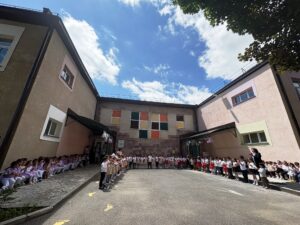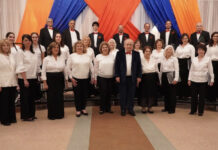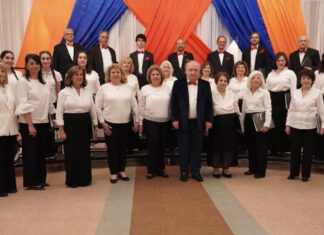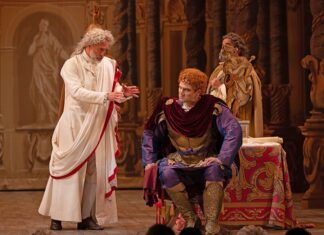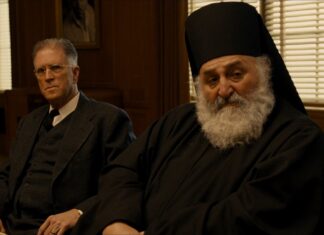NEW YORK — Hrair Hawk Khatcherian, who recently took a journey through Western Armenia, will speak at the Diocese of the Armenian Church of America (Eastern) on Thursday, September 9, at 7 p.m. at an event hosted by the Zohrab Center and the Armenian Network of America Greater New York region. The event is free and open to the public and will be followed by a wine and cheese reception.
Below is an interview Taleen Babayan, interim director of the Zohrab Center, recently conducted with Khatcherian about his work, his ties to Armenia and Karabagh, and his passion for photography.
Taleen Babayan: What inspired you to become a photographer?
Hawk Khatcherian: While at school at the age of 13 my friend’s brother used to run a photo center and when I asked how a picture was developed into an image, the answer was ‘you cannot do it, it is too difficult.’ This was a challenge for me to try photography, so I bought a tiny 110mm camera and started snapping at school and at the beach, and have been hooked ever since.
TB: What is the story behind your name “Hawk”?
HK: Again it was during my school years. Back in 1975 there were no e-mails, gmails, Facebook or Skype. We were pen-palling from one school in Lebanon to Michigan where a student by the name of Jamie Ledbetter was my pen pal. One day Jamie said please find yourself a nickname I can call you. Hawk is my favorite bird of prey for similar qualities, sharp eyes, independent, flight…. so the nickname was approved and I used to sign off my letters with “Hawk.” In 1992 I earned my wings as a commercial pilot in Hayward, Calif. and my nickname officially became my middle name, and today all my legal documents such as passports, driver’s license all bear the middle name “Hawk.”
TB: How does photography tie you to your ancestral homeland and to Armenians worldwide?
HK: The war in Karabagh was a true introduction for me of what my roots are. Back in 1988 when there were protests by the Armenians in front of the Soviet consulate in Montreal, they were bearing the signs “Karabagh is Armenia,” “Karabagh is for Armenians,” and when I asked the demonstrators what is Karabagh, they responded by saying Stalin had given the Armenian enclave to the Azerbaijanis back in 1922. My questions were many such as, have you seen the land, or have you seen the Armenians of Karabagh and their answer was no. So for the first time in 1992 I traveled to Armenia and three days later I was in the trenches rubbing shoulders with Armenians defending their land Karabagh or Artsakh as it is known for them. During the war a man gave me a book about the Armenian churches inside Karabagh and thus I started researching and photographing them. Cancer hit my lungs in 1993 and was given 10 days to die. It’s at this crossroad in my life I made a vow to photograph the Armenian churches worldwide and to capture our heritage on film in the beginning and digital nowadays. I have been totally cured and discovered the true passion and dedication in photographing our rich heritage in Karabagh, Armenia and historical Armenia (Turkey).
TB: Do you feel that you have been successful in presenting the beauty of Armenia and its people to the world through your photographs?
HK: The fact that the majority of the people who have seen my photographs see in them the reflection of my soul, which is simple and honest and beautiful in every sense. Friends tell me how a simple e-mailed photograph has made their day more positive and that is the best satisfaction any professional can get.
TB: Where is the one place in Armenia that residents and visitors do not know about but should?
HK: Armenia and Artsakh and historical Armenia are full of discoveries to be made, even though I have canvassed many corners of this entire region I am still at awe every time I discover for the first time a new place or a new hidden treasure, for example the Monastery of Yeghishe Arakyal in Northern Artsakh, the twin tallest khackars in Erzencan region in Turkey and the Khoraget in Northern Armenia and many places which can fill a few pages.
TB: How much of your work is about preserving history?
HK: My work is actually a passion of self-discovery and life, and I don’t consider it as work. At school I was not interested in history or literature or even Armenian history, and my teacher used to beat me with a ruler and many times breaking them on my head and uttering the words “you will never learn!” I guess my stubbornness led me to discover our heritage in many corners few people will venture to. And by doing so, I believe I am preserving our history and culture and trying to inspire the new generation to continue my work by getting inspired as I have been inspired by others, including the late Archbishop Mesrob Ashjian who literally took my hand in 1997 for the first time through historical Armenia and also the late Mr. Armen Hakhnazarian who for 30 years ventured and risked his life trying to document our heritage inside Turkey and Iran. They both
did contribute by publishing many books (more than 100 of them in the last 10 years of the late archbishop’s life alone!) Also following suit are seven books I have published, the latest one with co-author and designer Armen Kyurkchyan titled Armenian Ornamental Art, which is the fruit of 10 years of photography and graphic design.
TB: What is your favorite photograph that you have taken?
HK: In 1999, while waiting for the last rain drops to fall on top of the roof of our car which we had taken shelter in for more than an hour, I stepped out in Southern Armenia with my camera and lens pointing at a ruined church. Not much was inspiring even though a few clicks were fired, and as I was heading back to the car, I bowed at the secondary altar to have a peak and there it was that a bird must have dropped a seed on the window and only dust as growing base this thin plant had shot upward defying logic. Thus, it gave me the title for this shot, “Window for Life,” and I use it as the cover page for my website.
TB: As someone who has visited more than 40 countries in the past 17 years, where specifically is your favorite place to shoot?
HK: It is so amazing to travel and see 44 countries and have passion to live and discover people and the beauty of the earth. The world is such a small place yet divine and majestic like Mt. Ararat, which I used to photograph for its beauty and symbolism, but seeing it made me realize how humble and tiny we are inside nature’s womb, thus respect and awe are what I am left with, and Armenia, Artsakh and historical
Armenia are one tiny part of the earth I am still discovering, and from high above — no man-made borders and no boundaries can limit its awesome beauty. The salmon returns from the ocean back to the river where it was born and lays eggs, same here, the call of our heritage is naturally attracting me like a powerful magnet to Armenia.
TB: What do you see as your greatest accomplishment?
HK: Life and its challenges are still a long process in my daily life. I have so much more to learn, to discover, to capture and to share. Life is beautiful, life is living and I live on a daily basis. Every minute is appreciated — that is my accomplishment.
TB: What advice would you give young Armenian photographers who aspire to follow in the footsteps of Yousef Karsh, Hawk and other talented Armenian photographers?
HK: We are all inspired by others, like I am by Henri Cartier Bresson, Karsh, Ara Guller. I have no advice; just live life, shoot from the heart and take no prisoners.
